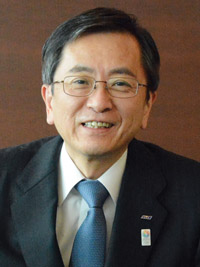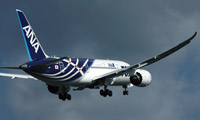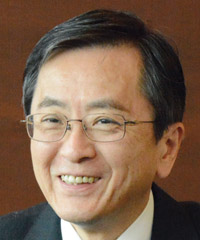Cover Story
SHINOBE ENGINEERING ANAS FUTURE
Overseas investment a priority to expand the airline brand
June 1st 2013
From an aircraft maintenance workshop at Tokyo’s Haneda Airport to the boardroom of Japan’s leading airline has been an eventful journey for Osamu Shinobe, who was appointed president and chief executive of All Nippon Airways (ANA) in April. Read More »
 |
| 'Airlines are always facing risk. Risk management is part of the game' |
| Osamu Shinobe President & CEO All Nippon Airways |
The first CEO to have risen from the ranks of the maintenance division of the airline, Shinobe‘s top priority has been to supervise the resumption of commercial service of the carrier’s B787 Dreamliner fleet.
The launch customer’s 17 Dreamliners – it has another 49 on order - were grounded on January 16 prior to the grounding of the global fleet of B787s, after a battery overheated on a domestic flight and forced an emergency landing. At press time the fleet was due to resume service on five international routes and 14 domestic routes on June 1.
Shinobe, 60, was appointed leader of the carrier’s B787 project team in 2007, the year he was elected to the ANA board. In the crisis that followed the grounding of the B787s, the former maintenance man became ANA’s public face in handling the safety concerns of the Dreamliner.
As 35% of the aircraft is made in Japan and because half the present global fleet of 50 Dreamliners belongs to Japanese carriers, with ANA currently the largest operator, the issue has attracted a lot of interest in the country.
It came as little surprise to airline insiders that Shinobe was picked as successor to Shinichiro Ito, who has moved to the presidency of the new ANA holding company in a major reorganization of the ANA Group’s corporate structure.
As a senior executive vice-president, Shinobe worked closely with Ito, helping him navigate the airline through the impact of the 2008 global economic crisis, dubbed the Lehman Shock in Japan, and the impact of the 2011 Great East Japan Earthquake. In the new set-up, Ito and Shinobe will continue to work together.
In 1976, fresh from graduating from the department of engineering at Tokyo’s prestigious Waseda University, Shinobe joined ANA’s engineering and maintenance division. Recognized early for his management abilities, he served 20 years in engineering and maintenance, with spells in corporate planning and quality assurance, followed by senior posts in marketing and product planning. He returned to head the engineering and maintenance department in 2008.
 |
| All Nippon Airways: B787s back in service |
In recent years, he has been credited with ANA’s highly effective cost-cutting efforts following the Lehman Shock, which largely restored the airline’s profitability. He also oversaw the successful public share offering in August last year. This provided ANA with a war chest of 170 billion yen (US$1.683 billion) for its future aircraft purchases and joint venture plans in Japan and Asia.
The only time his march up the company career ladder went on hold was when he served as a union official for four years. However, on his return to regular airline work he initially refused a two-step promotion on the grounds that it was outside usual company custom. His colleagues said this illustrates his deep respect for principles and order.
Following the Japan Civil Aviation Bureau’s April green light for ANA and Japan Airlines’s B787s to return to service after Boeing’s modification of the aircraft’s batteries, ANA started an intensive re-familiarisation programme for 180 cockpit crew, on 230 test flights.
ANA’s next step will be to seek compensation with Boeing, said Shinobe. The president declined to elaborate, but revealed an airline project team was working on a compensation plan.
A company source revealed that estimates of revenue loss from mid-January to the end of May were 12.5 billion yen (US$122.5 million) with operating losses about half that figure.
In all, 2,662 domestic and 939 international ANA flights were cancelled. On domestic B787 routes, about 75% of flights were replaced with other aircraft. To help cope with the situation, ANA delayed the retirement of four aircraft and asked Boeing to advance deliveries of two airplanes.
Shinobe also played a major role in creating the new corporate structure, heading up the team that prepared the launch of ANA Holdings.
 |
| 'In Japan, we are well known. In the global arena we are a relatively small airline. So we want to leverage the internationally recognized qualities we have' |
| Osamu Shinobe |
The new company holds the shares of 57 consolidated subsidiaries, including AirAsia Japan, other aviation related subsidiary companies and 19 affiliates. The list also includes travel service companies, product sales, property management, human resources and catering.
“There are two fundamental objectives in setting up the new corporate structure,” Shinobe told Orient Aviation.
“One is to accelerate the speed of management decisions. ANA is now an operating company under the holding company and can focus on its own objectives. For that it is better to have a quicker decision-making style.
“The second is that we can adopt a multi-brand strategy. ANA is a full-service airline (FSA). However, within our group we have LCC (low-cost carrier) brands, such as Peach and AirAsia Japan, which use a new business model.
“We would like these airlines to compete with each other and grow on their own, underneath the holding company structure.”
Last year’s share sale will provide the holding company with the opportunity to invest overseas, particularly in Asia. It is focusing on India, Thailand and in other emerging Asian economies where ANA operates, such as Myanmar. To maximise those opportunities, the ANA holding company is establishing a wholly-owned investment company in Singapore
The ANA Group, through the holding company, is considering investing in airport terminal management and air transport related activities where the group has the necessary expertise to develop ancillary revenue.
“We have to look overseas as domestic competition intensifies,” said Shinobe. “Our core strategy as an airline has been to focus on Asia. This is where air travel demand is growing at the greatest rate worldwide.
“Of course, we can expand our network alone, but there would be some limitations if we did so. It is quite natural to set up an investment company in Asia to look for business opportunities as well as partners.”
ANA’s international business has been affected recently by Japan’s diplomatic spats with neighbours, China and Korea, over territorial disputes. These incidents sent demand for leisure traffic plunging. Other issues, such as the fear of bird flu, have added to the troubles.
| Eccentric samurai an inspiration A staunch believer in physical fitness, Osamu Shinobe regularly goes for long walks in his neighborhood park in the western suburbs of Tokyo. “I used to jog, now I’m down to walking, but these days it’s difficult to do it as frequently as I would like,” said the 60-year-old CEO. Married, with two adult children, he is also a history buff. “I find history fascinating. Sometimes I think that history has an influence on me in making certain judgments,” said Shinobe. One of his heroes is Sakamoto Ryoma, a highly unconventional samurai of the mid 19th century who played a significant behind-the-screens role in the unification of Japan and the creation of the Meiji Restoration of 1868 - the start of modernization of the country. Although rated as one of Japan’s top swordsmen, Ryoma carried a six-shot revolver and wore British-style boots. “Ryoma achieved amazing results in his short life – he died when he was only 30. I find great inspiration from his story,” said Shinobe. |
Business traffic on these routes is returning, but leisure demand is still sluggish, said Shinobe.
The president said the airline enjoyed a record net profit of 28.1 billion yen in 2011 and 43.1 billion yen, a record again, in 2012, before the territorial issues returned to the fore. ANA expects the record-breaking trend to continue in the current financial year, forecasting a net profit of 45 billion yen, despite the B787 problems.
Shinobe takes the long view on the airline’s business with the key neighbouring markets.
“The airline industry is a volatile business. We’re always facing issues and you have to be prepared. When there are fluctuations in demand we need to be creative in our response by changing aircraft size or flight frequency to match the situation. If we can’t secure enough sales then we have to cut costs,” he said. “Airlines are always facing risk. Risk management is part of the game.”
Observers said ANA was taking a risk last year when the carrier launched two new LCCs, Peach Aviation in Osaka, and Narita-based AirAsia Japan. Peach, a joint venture with a Hong Kong investment company, First Eastern Investment Group, and Japanese consortium, Innovation Network Corporation, launched in March 2012 and AirAsia Japan, a joint venture with AirAsia, first flew last August.
The new LCCs have defied critics who believed Japanese passengers would not favour the no-frills LCC style of flying. Peach flew its two millionth passenger last month, well ahead of forecasts.
“Peach has performed very smoothly and there’s been a good reaction from travellers in the Kansai region, as the figures show”, said Shinobe.
AirAsia Japan has had a more difficult time establishing itself than expected, he said, mostly because of intense LCC competition at Narita and other operational constraints.
“The carrier also needs greater public awareness,” said Shinobe. “Nevertheless, we can say that LCCs are being accepted by the Japanese travelling public and new demand is being tapped”, he said.
Meanwhile, anti-deflation measures promoted by the ruling Liberal Democratic Party (LDP) are having an impact on the Japanese economy. The yen has weakened, good for exporters, but it is pushing up the costs of fuel and aircraft for Japanese carriers.
 |
| Peach Aviation: the ANA low-cost carrier has reached two million passengers, well ahead of forecasts |
Shinobe diplomatically pointed out that the measures, called “Abenomics” after Prime Minister Shinzo Abe, are designed to stimulate the whole economy. As a result there could be major benefits from improved cargo volume and business travel, as Japanese exports pick up.
A member of the Star Alliance since 1999, ANA sees it as part of its international growth strategy. “Membership gives us tremendous economic value. It also helps us give our customers more options such as mileage benefits, lounge use, access to a more efficient network, better connections and better schedules,” said Shinobe.
ANA has built on this by creating joint ventures with UAL Continental Holdings for Pacific routes in 2011 and with Lufthansa and its partners between Europe and Japan in 2012.
The U.S. collaboration resulted in 4.1 billion yen in sales revenue last year – double 2011 - while the ties with the German airline netted 1.6 billion yen. The results are expected to continue to improve.
Shinobe is seeking ways to develop these ventures by aligning ANA’s flights with the joint venture partners’ networks.
The return of the B787 to service means ANA can resume operations on two new routes, Narita-San Jose and Narita-Seattle, suspended during the grounding. The carrier’s route planners are looking at possible new destinations.
Istanbul, hub of Star member, Turkish Airlines, is being studied, said Shinobe. United Air Lines will launch a Denver-Tokyo route this summer and ANA will keep an eye on how that performs with a view to an opportunity.
Shinobe was largely non-committal on ANA’s fleet planning. “We will have to think about 777 replacement eventually, but we are not actively studying specific aircraft at this point. We are always interested in new aircraft, such as the A350 and the 777X, and welcome what the manufacturers have to tell us,” he said.
But ANA is not as yet in the market for larger jets like the A380 or the B747-8.
“There was a time when, because of airport requirements, big aircraft were more efficient and economical [for us], but circumstances have changed. Given the current environment, we’re not considering such aircraft at this time,” said Shinobe.
For services between local cities ANA has 25 Mitsubishi Regional Jets on order, 15 firm with 10 options. They are due to enter service from the second half of 2015.
How does Shinobe see the ANA brand shaping up for the future?
“To be the best airline in Asia or one of the best global airline groups we have to differentiate ourselves from competitors and to grow further through our international business,” he said.
“That’s why we are taking advantage and investing in slot expansion in the metropolitan airport area to entice passengers to fly with us. ANA’s international seat kilometres by the end of the year will be 25.9% greater than in 2011.
“In Japan, we are well known. In the global arena we are a relatively small airline. So we want to leverage the internationally recognized qualities we have, such as the Skytrax 5-star rating, which has international recognition, to catch more customers from overseas.”
The B787 grounding overshadowed the long-planned major structural changes in the ANA Group, but did not distract from their implementation.
Shinobe handled the sensitive issue well and won praise from the industry and customers alike.
Now, while his former boss, Shinichiro Ito, seeks business opportunities for the new ANA holding company, Osamu Shinobe is applying his engineer’s discipline to the task of developing the ANA brand in its goal of becoming a leading global player.
Photos: KAKU KURITA